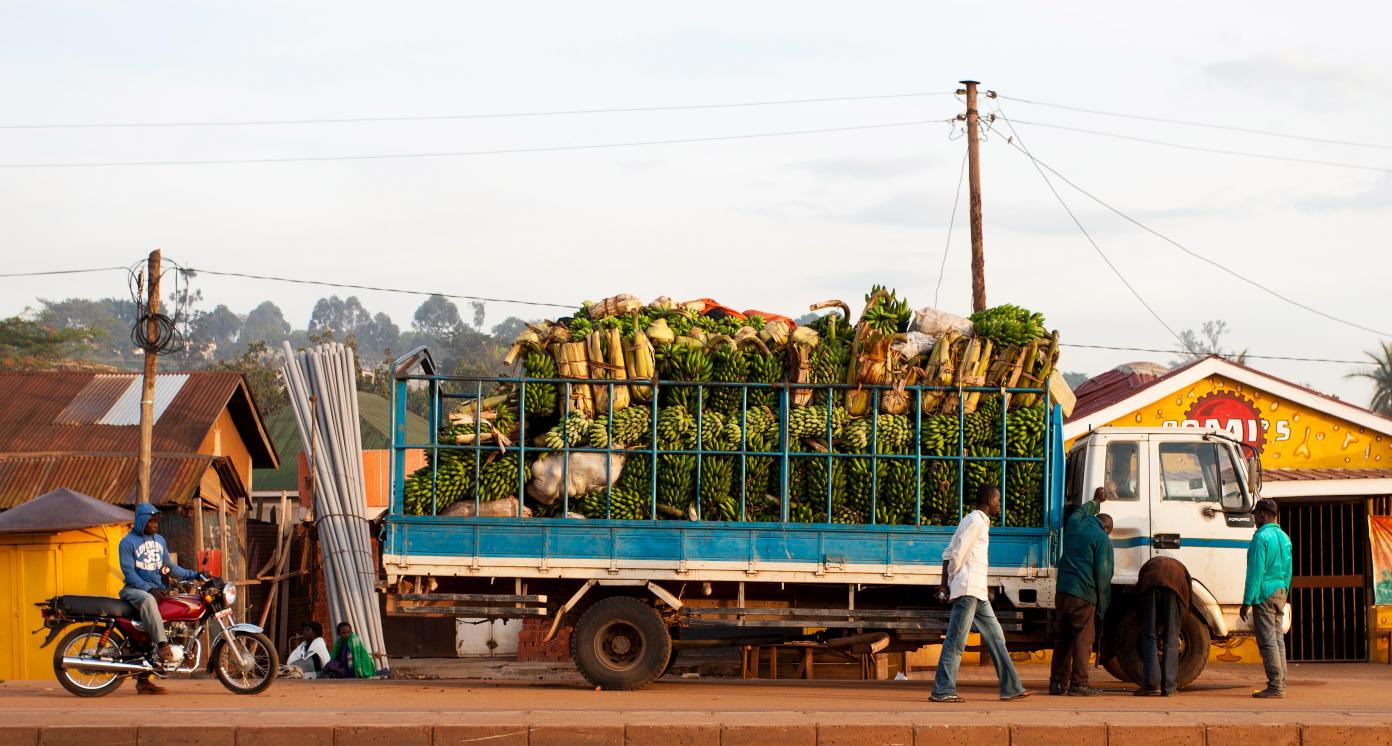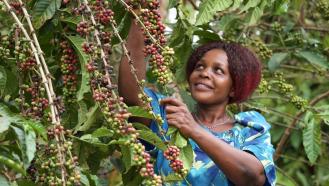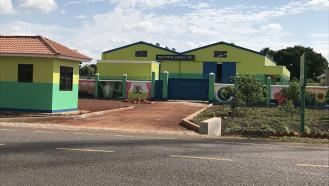Food processing and collection services






Business Model Description
Process and aggregate from a cluster of farms commodities, especially coffee, tea, cotton, cassava, maize, vegetable oil, fish, dairy and beef.
Expected Impact
Address post-harvest losses and increase value adding of agricultural products for local consumption and export.
How is this information gathered?
Investment opportunities with potential to contribute to sustainable development are based on country-level SDG Investor Maps.
Disclaimer
UNDP, the Private Finance for the SDGs, and their affiliates (collectively “UNDP”) do not seek or solicit investment for programmes, projects, or opportunities described on this site (collectively “Programmes”) or any other Programmes, and nothing on this page should constitute a solicitation for investment. The actors listed on this site are not partners of UNDP, and their inclusion should not be construed as an endorsement or recommendation by UNDP for any relationship or investment.
The descriptions on this page are provided for informational purposes only. Only companies and enterprises that appear under the case study tab have been validated and vetted through UNDP programmes such as the Growth Stage Impact Ventures (GSIV), Business Call to Action (BCtA), or through other UN agencies. Even then, under no circumstances should their appearance on this website be construed as an endorsement for any relationship or investment. UNDP assumes no liability for investment losses directly or indirectly resulting from recommendations made, implied, or inferred by its research. Likewise, UNDP assumes no claim to investment gains directly or indirectly resulting from trading profits, investment management, or advisory fees obtained by following investment recommendations made, implied, or inferred by its research.
Investment involves risk, and all investments should be made with the supervision of a professional investment manager or advisor. The materials on the website are not an offer to sell or a solicitation of an offer to buy any investment, security, or commodity, nor shall any security be offered or sold to any person, in any jurisdiction in which such offer would be unlawful under the securities laws of such jurisdiction.
Case Studies
Country & Regions
- Uganda: South Western
- Uganda: Acholi
- Uganda: East Central
- Uganda: Central
Sector Classification
Food and Beverage
Development need
70% of Ugandans are employed in agriculture (IX), and the sector constitutes approximately a quarter of gross domestic product (GDP) and a large proportion of exports (III). The agriculture sector is marred by low levels of productivity and output, mainly caused by poor agricultural practices as well as the impacts of climate change.(VII)
Policy priority
The government supports the development of the agriculture sector, emphasising agro-industrialisation in the Third National Development Plan 2020/21 – 2024/25.(IV) The Vision 2040 recognises agriculture as one of the key pillars for the country's development and acknowledges the need for innovation and integration of the sector.(X)
Investment opportunities introduction
Approximately 80% of Uganda's land is arable, however only 35% is currently being cultivated. Agricultural development is predicted to contribute to domestic wealth creation and increased employment.(IV)
Key bottlenecks introduction
The Agriculture Sector Strategic Plan 2015/16 - 2019/20 provides a detailed analysis of opportunities and challenges in agriculture, emphasising agro-processing, innovation, improvement of skills and establishment of market linkages, which will help transform the sector towards industrialisation and higher value adding.(IV)
Food and Agriculture
Key bottlenecks introduction
The main challenges in food and agriculture and with processed foods include: poor access to electricity, frequent underutilization of processing facilities (due to poor aggregation of products from farmers), lack of inputs, high transport costs and a lack of skilled employees.
Processed Foods
Pipeline Opportunity
Food processing and collection services
Process and aggregate from a cluster of farms commodities, especially coffee, tea, cotton, cassava, maize, vegetable oil, fish, dairy and beef.
Business Case
Market Size and Environment
> USD 1 billion
Agro-processing is a key contributor to gross domestic product (GDP) from manufacturing. It accounts for around 60% of manufacturing output.(3) It also recorded strong growth of 8% in 2017.(2)
Food sales in Uganda are expected to rise by 11.1% in 2020, 13.3% in 2021, 7.6% in 2022, 14.3% in 2023 and 6.9% in 2024. By 2024, they are expected to be worth USD 16 billion.(4)
The rapid increase in population - 3.2% annually - and increasing wealth of the society are driving the market for more processed food of higher value.(2) The growth potential of the sector (especially dairy) was also confirmed during interviews with companies active in the sector.(17)
Indicative Return
15% - 20%
Benchmark statistics for the food processing sector estimate a return rate between 15% and 19%. This rate is a benchmark, calculated as the cost of equity with a country risk premium, reflecting an average return required by investors.(14)
As an example, Mujaasi Investments which is aggregating, processing and marketing various food (including fruits) has a projected internal rate of return (IRR) of 233% over 5 years.(8)
A Kenyan company, the Best Tropical Fruits is expecting investment in fruit processing will generate an IRR around 126%.(8) A case study on Kenyan investments tackling post-harvest loss reduction estimates a 28% IRR in 10 years.(13)
Investment Timeframe
Medium Term (5–10 years)
Research suggests investment in food processing is expected to have an average repayment period of 5 to 10 years.(8)
Different active stakeholders in the sector estimated the timeframe to be 7 years, according to interviews.(15)
Market Risks & Scale Obstacles
Market - Highly Regulated
Business - Supply Chain Constraints
Impact Case
Sustainable Development Need
Although agricultural value added in Uganda is growing, agricultural value added per worker (constant 2010 USD) has decreased from USD 1,250 in 2002 to USD 910 in 2019. This demonstrates the need to accelerate agricultural value adding.(1)
In Uganda almost 70% of population are employed in agriculture and 90% of poor people live in rural areas. Agro-processors have incentives to aggregate smallholders into value chains and thus drive their productivity. However, many processors report underutilization up to as much as 60%.
The uptake of agricultural products by processors can also reduce post-harvest losses, which were estimated at around 12.4% - 17.6% for cereals.(6) Other more perishable commodities have even higher post-harvest losses.
Gender & Marginalisation
Women, as a critical part of the agricultural workforce, are particularly affected by low productivity, and their livelihoods suffer from post-harvest losses.
Rural communities, as the backbone of agricultural production, suffer critically from the low productivity and the underutilization of agricultural products for processing.
Expected Development Outcome
Increased income of smallholder farmers; increased export value; satisfied demand of developing society; reduced post-harvest losses
Increased value adding of supply chains; increased employment opportunities; extended shelf life of food products; improved productivity and produce utilization; new job opportunities
Decreased food losses; decreased infrastructural and access to processing facilities gaps in the country; increased processing facilities utilization due to aggregation of produce from smallholders
Gender & Marginalisation
Increased agricultural productivity is expected to positively impact women, as critical workforce.
Primary SDGs addressed

2.3.2 Average income of small-scale food producers, by sex and indigenous status
2.c.1 Indicator of food price anomalies

8.2.1 Annual growth rate of real GDP per employed person
8.4.1 Material footprint, material footprint per capita, and material footprint per GDP

12.3.1 (a) Food loss index and (b) food waste index
Secondary SDGs addressed



Directly impacted stakeholders
People
Public sector
Indirectly impacted stakeholders
People
Outcome Risks
Considerable part of processed food is shipped abroad which limits the local amount of food.
Food processing will increase its price and reduce affordability for poor households.
Impact Classification
What
Likely to have a positive impact because it increases the income of smallholder farmers, reduces post-harvest losses and increases utilization of agro-processors and agricultural value adding.
Who
Smallholder farmers whose food perishes because they have poor connections to market. The result is low incomes that prevent them from developing.
Risk
Although the model is market proven, many processors report operating under capacity, so aggregating smallholders is key to avoiding this risk.
Impact Thesis
Address post-harvest losses and increase value adding of agricultural products for local consumption and export.
Enabling Environment
Policy Environment
Uganda National Development Plan: This plan recognizes agro-processing as a driver of manufacturing and agriculture. By 2025 the government aims to increase manufacturing's share of gross domestic product (GDP) from 19% to 25%, industry growth from 3.8% to 5.1%, and the value of manufactured exports in total exports from 13% to 20%.(IV)
Agriculture Sector Strategic Plan: This plan presents the overall strategy for agriculture development. Although the newest version for 2020-2025 is being drafted, like previous versions, it will strongly support agro-processing and focus on the efficiency of value chains.(3)
The budget speech for 2019/20 highlighted the target of “Industrialization for job creation and shared prosperity”, which requires strengthening supply chains.(3)
Overall government policy emphasizes the smallholder out-grower business model. It involves aggregating farmers from a certain geographical area for a joint processing value chain.(2)
Financial Environment
Fiscal incentives: Items necessary for processing are exempt from value added tax (VAT) and other taxes, such as refrigerated trucks, agricultural tractors, alumni cans for dairy industry, heat insulated milk tanks for the dairy industry, insulated tankers, cold rooms, machinery for processing dairy products.(11)
Other incentives: Agro-processing companies have priority for subsidized land in industrial parks and free zones. Examples from Kampala include Uganda Investment Authority selling land there for around 80% of its market value.(10)
Regulatory Environment
The Constitution of Uganda states the government will stimulate the agriculture and industry. These principles are further translated into the existing Vision 2040.(9)
National Standards and Quality Policy 2012: This policy provides the framework for standardizing and maintaining the high quality of products.(9)
Draft National Industrial Policy 2018 and Draft National Industrial Development Strategy: These policies established strategic agro-processing industries including fruit processing, coffee processing, cotton, textiles and apparel, tea processing and livestock (including meat, dairy and leather products).(10)
Uganda's Land Act 1998 and its revisions, together with National Land Policy 2013, were designed to coordinate land for national development.(5)
The Ministry of Trade, Industry and Cooperatives is the main body responsible for creating industrial policy and regulations. However, it was recognized as lacking power to influence industrialization, so some industrial projects are conducted by other ministries.(10)
Marketplace Participants
Private Sector
Uganda Development Bank, Pearl Capital Partners, ICCO, Kigezi highland Ltd, Afro-Ka, Stemuka Foods Ltd, Unga Millers (U) Ltd, Your Choice Ltd, East African Basic Foods Ltd, Sesaco Limited, CECOFA, Mujaasi Investments
Government
Ministry of Agriculture, Animal Industry and Fisheries; Uganda Export Promotion Board; Ministry of Trade, Industry and Cooperatives,
Multilaterals
African Development Bank (AfDB), European Union (EU), International Fund for Agricultural Development (IFAD)
Target Locations
Uganda: South Western
Uganda: Acholi
Uganda: East Central
Uganda: Central
References
- (I) Sachs, J., Schmidt-Traub, G., Kroll, C., Lafortune, G., Fuller, G., Woelm, F. (2020). The Sustainable Development Goals and COVID-19. Sustainable Development Report 2020. Cambridge: Cambridge University Press. (II) United Nations Development Programme (2019). Briefing note for countries on the 2019 Statistical Update: Uganda. (II) Ministry of Agriculture, Animal Industry and Fisheries. Agricultural sector potential in Uganda. https://www.agriculture.go.ug/agricultural-sector-potential/ (IV) National Planning Authority. National Development Plan III (NDPIII) 2020/21 – 2024/25. (V) Fowler, M. and Rauschendorfer, J. (2019). Agroindustrialisation in Uganda. https://www.theigc.org/wp-content/uploads/2019/11/Fowler-and-Rauschendorfer-2019-working-paper.pdf (VI) Rakotoarisoa, M.A., Iafrate, M. and Paschali, M. (2011). Why Has Africa Become a Net Food Importer? http://www.fao.org/fileadmin/templates/est/PUBLICATIONS/Books/AFRICA_STUDY_BOOK_REVISED_low_res.pdf (VII) Government of Uganda. Uganda Green Growth Development Strategy (UGGDS) 2017/18 – 2030/31. (VIII) United Nations Development Programme (2019). Inequalities in Human Development in the 21st Century. Briefing note for countries on the 2019 Human Development Report. Uganda. (IX) World Bank (2018). Making Farming More Productive and Profitable for Ugandan Farmers.https://www.worldbank.org/en/country/uganda/publication/making-farming-more-productive-and-profitable-for-ugandan-farmers (X) Government of Uganda. Uganda Vision 2040. https://consultations.worldbank.org/sites/default/files/materials/consultation-template/materials/vision20204011.pdf
- (1) World Bank database. https://data.worldbank.org/
- (2) Centre for Development Alternatives (2019). Agro-Processing: A Gateway to Inclusive Structural Transformation in Uganda? https://cda.co.ug/1986/agro-processing-a-gateway-to-inclusive-structural-transformation-in-uganda/
- (3) Fowler, M. and Rauschendorfer, J. (2019). Agroindustrialisation in Uganda. https://www.theigc.org/wp-content/uploads/2019/11/Fowler-and-Rauschendorfer-2019-working-paper.pdf
- (4) FitchSoultions (2020). Uganda Agribusiness Report Includes 5-year forecasts to 2024. Q3 2020.
- (5) Minister of Finance, Planning and Economic Development (2018). National Investment Policy (NIP) of Republic of Uganda Draft.
- (6) Food and Agriculture Organization of the United Nations (2019). Government of Uganda, FAO, WFP, IFAD make strides in development of a comprehensive strategy plan to reduce post-harvest losses in grains. http://www.fao.org/uganda/news/detail-events/es/c/1198628/#:~:text=Food%20losses%20contribute%20to%20and,produced%20in%20the%20country%20respectivel
- (7) Uganda Investment Authority (2019). Bankable Projects 2019/2020 - 3rd Edition. https://www.ugandainvest.go.ug/wp-content/uploads/2019/06/BANKABLE-PROJECTS-2.pdf
- (8) Alliance for a Green Revolution in Africa (2019). The Agribusiness Deal Room at the 2019 African Green Revolution Forum (AGRF). https://agrf.org/dealroom/wp-content/uploads/2020/07/Agribusiness-Deal_Room-AGRF-booklet_020919.pdf
- (9) Economic Policy Research Centre (2018). Fostering a Sustainable Agro-Industrialisation Agenda in Uganda. https://eprcug.org/research/research-reports/579-fostering-a-sustainable-agro-industrialisation-agenda-in-uganda/download
- (10) Konrad Adenauer Stiftung (2020). Industrial Policy for Economic Transformation in Uganda. https://www.kas.de/documents/280229/9581001/CDA_KAS+Reality+Check+12_Industrial+Policy+for+Economic+Transformation+in+Uganda.pdf/34cdb812-3de4-87e2-7281-0256682ba53f?t=1594904315863
- (11) Uganda Revenue Authority (2019). A Guide on Tax Incentives /Exemptions available to the Uganda Investors. https://www.ebiz.go.ug/wp-content/uploads/2020/03/TAX_INCENTIVES_GUIDE_FOR_INVESTORS_IN_UGANDA_October_2019.pdf
- (12) Adams, F. et al. (2019). 'Financial analysis of small-scale mango chips processing in Ghana', Cogent Food and Agriculture. https://www.tandfonline.com/doi/full/10.1080/23311932.2019.1679701
- (13) Mujuka, E., Mburu, J., Ogutu, A. and Ambuko, J. (2017). Returns to investment in postharvest loss reduction technologies among mango farmers in Embu County, Kenya. https://onlinelibrary.wiley.com/doi/full/10.1002/fes3.195
- (14) PwC analysis based on Prof. A. Damodaran data, 2020.
- (15) UNDP/PwC stakeholder interviews, 2020.
- (16) Food Security (2018). Nucleus-outgrower schemes as an alternative to traditional smallholder agriculture in Tanzania – strengths, weaknesses and policy requirements. https://d-nb.info/1171128797/34#:~:text=lack%20of%20infrastructure%20(particularly%20in,of%20labour%20supply%20(in%20certain
- (17) UNDP / PwC private sector interviews, 2021.

















